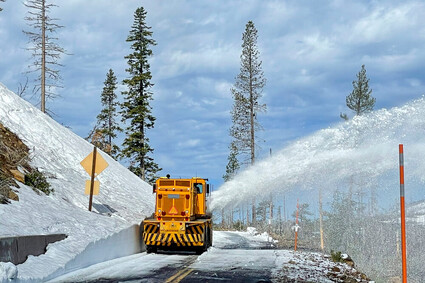ODOT budget woes could impact Sisters
Last updated 6/6/2023 at 2:17pm
Last week, George Ormsbee, Russ Bentley, Krista Garner, Mike Romine, and Colton Tennant of Oregon Department of Transportation (ODOT) "blew" Highway 242. Highway 242 is a state highway that runs from Belknap Springs through McKenzie Pass to Sisters. It is part of the McKenzie - Santiam Pass National Scenic Byway that was added to the National Register of Historic Places in February, 2011 and is on the bucket list of cyclists across the region, indeed the world.
The highway is closed sometime in October or November due to snow and reopens usually in late May or early June as snow melts. The task of reopening is a Herculean effort requiring monster machinery and human skill. It takes at last two snow blowers (not plows) to clear the road.
The equipment can cost as much as $500,000 each. And ODOT's funding woes may mean "blowing" 242 could be a thing of the past, axed by budget cuts on the horizon.
The Nugget accompanied the crew. Our view was from the cabin of a 1991 Schmidt. In the lead was a two year old LaRue. Both are ribbon- design beasts that can chew up snow and spit it 60 feet - not your hardware-store sidewalk snow blower.
Tourism in Sisters relies in substantial part on HIghway 242 being open for cyclists - pedal-powered and motorcycles - some of whom come from Europe and Australasia. It is 13 miles of gentle uphill and 17 miles of thrilling downhill in one of the most scenic areas in the U.S.
The road follows an 1860s wagon route where you earn stunning views of the Cascades and a vast 2,000-year-old lava flow. You find yourself riding serpentine between lava-rock walls just before reaching the summit.
The summit showcases another unique feature of this ride, the lava-rock-constructed Dee Wright Observatory, which provides 360-degree views of mountains, buttes, and other formations framed by windows from inside the rocky structure.
The 4,000-foot descent to Highway 126 snakes down exhilarating switchbacks to dense, lush Cascadian forests, and rushes over the McKenzie River. This dramatic transition from the east side of the Cascades highlights the diversity of the natural surroundings and defines the uniqueness of the famed bikeway.
The annual reopening takes days. Beyond the snow, in some places still five to six feet in depth, there are downed trees and rockslides that have to be cleared.
ODOT gets the vast majority of its funding from the gas tax, that 36.8 cents per gallon we pay every time we fuel our cars and trucks. In the last 10-15 years cars and pickups have become increasingly more fuel efficient. Less gas, less tax.
Then COVID appears to have changed forever the way employees work, with thousands in Oregon working remotely from home or on a reduced workweek schedule, using less gas. The rise in all electric vehicle use, while still at 1 percent in Oregon, is increasing and currently around 4,000 are registered in the state. They don't use gas - thus no gas tax.
That's been a triple whammy to ODOT, who may be facing the unthinkable: a reduced workforce (layoffs). The legislature is considering fee hikes at DMV to cover the gap. Without relief, ODOT says it will run out of cash before the end of the 2023-2025 biennium, having already drawn down much of its reserve fund. By 2029, the agency projects a $680 million deficit. The agency spends more than $5 billion per biennium, with $1.5 billion going toward roadway and bridge maintenance and repair.
"We can't run a deficit of that size, or any size," said Travis Brouwer, the agency's assistant director of finance.
If it goes into the red, ODOT says it will have to slash basic maintenance services. That could mean fewer crews to clear roads after a crash, plow snow during storms, or fix potholes and broken guardrails. And blowing Highway 242.
In that scenario, "we'd have to let mother nature do the job, waiting for the snow to melt on its own," said Ormsbee.
"That could be August in some years," Bentley added.
Oregon House Bill 2100 proposes hikes for commercial and regular Class C driver license tests and renewal fees. Some increases would more than double, such as the cost of a commercial driver license from $75 to $160, and quintuple the cost of a regular license test from $9 to $45.
ODOT estimates the fee hikes would raise an additional $18 million for the 2023-2025 biennium, temporarily staving off the deficit. For the following biennium, the bill would raise an estimated $25 million.
"That wouldn't solve ODOT's long-term budget problems, but it's a start," Brouwer said.
"It will take the edge off, plug the deficit for the next biennium, and hopefully alleviate the need to make reductions at DMV."
Joe Cortright is president and principal economist of Impresa in Portland, a consulting firm specializing in regional economic analysis, innovation, and industry clusters.
In recent House testimony, he said, "ODOT has shown no ability to manage project costs, with every major project incurring massive cost overruns. The agency is moving to start construction on these projects and commit the State to paying for them without a financial plan in place. It claims it will use toll revenues to pay for megaprojects, but has no experience collecting or accurately estimating tolls.
"Repaying the debt incurred for these projects will take legal precedence over all other state transportation priorities, leading to further cuts in maintenance and repair, and jeopardizing every other capital construction project in the state."


















Reader Comments(1)
Glenn writes:
ODOT has for years cleared the pass as early as March. Then along with USFS and Sisters' then mayor/bike shop owner, they all misled the public and locked us out until the 3d week in June so they, their customers and Cycle Oregon could have McKenzie Pass to themselves for 2-3 months each spring.
05/24/2023, 2:39 pm